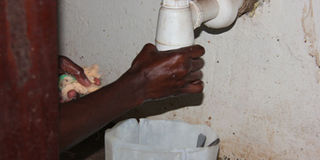Unblocking a clogged sink

Photos by Abubaker Luboowa
Sinks are very helpful kitchen accessories that are used for washing utensils and at times vegetables and fruits.
They are necessary in today’s modern-day kitchen. Most kitchens these days are constructed with provisions for a kitchen sink which is usually large enough to cope with the considerable volume of washing.
However, the sink which is usually connected to a drainage system of the house is a delicate unit and as such, requires proper care and maintenance.
James Mugisha, a plumber says sinks are prone to blockage when they are used for washing plates and in cases where you pour food remains in the drain.
He also adds that at times a blocked sink blockage can also be due to blockage in the drainage system usually around the inspection chambers.
Mugisha says undisciplined home owners do not sieve the water they pour in the sink and as such, end up pouring in everything including food remains.
“These food remains build up over time and eventually clog up the pipes preventing water from flowing thus causing flooding in the kitchen,” he says
There are signs of a blocked sink; the first sign as Mugisha puts it, is blockage of the water from flowing out. This causes water to accumulate in the sink because it’s not getting out.
Another sign is a stench that usually comes as a result of stagnation of water in the drainage system. This usually forces the water to flow back up causing an overspill and the production of a bad smell.
If you find yourself faced with any of the above, do not despair as you can fix this problem yourself, by simply following the steps below as presented by the plumber.
1. control water flow You should start by putting the plug in the plughole. This is done to prevent water from flowing back up.
2. drain the water Place a bucket under the sink pipe to collect any water that may still be flowing to avoid wetting the floor. Position it properly.
3. Open the pipe
Carefully unscrew the pipe and check for any clogged debris.
4. Checking the cap : Check the bottle cap for any accumulated dirt or blockage material.
5. clean the pipe
Rinse the pipe out thoroughly, remove anything that is blocking it. Try using a stiff wire to poke out the blockage. This will push out any dirt clogging the system.
6. put bottle cap back Carefully replace the bottle cap and screw back the pipe before removing the bucketpipe and check for any clogged debris
7. wash plughole Pour boiling water and liquid soap down the plug hole to clear any remaining debris.




